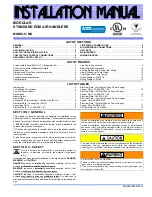
REC Indovent AB, Box 37, SE-431 21 Mölndal, Sweden
|
+46-31-675500
|
www.rec-indovent.se
INSTALLATION
Air Handling Unit RT 250/400S-EC-RS
3
Safety
Read this user's guide carefully before installing the
Air Handling Unit (abbreviated AHU), particularly
those parts marked with the above safety sign.
If you use and care for your AHU in a correct way, it
will perform in the best possible way for a long time.
The AHU creates an indoor climate that is very
good, at the same time as energy is saved due to
efficient heat recovery.
NOTE! This user's guide should be stored together
with the AHU, and should be passed on to possible
new owners.
Receipt of goods
Check the following before you sign the delivery
note:
•
the number of cartons should conform to the
delivery note/packing list
•
there should be no visible transport damages.
The AHU should be stored indoors.
If possible, store the AHU laying down before
installation, in order to avoid it tipping over. This is
particularly important if there are children around.
Installation - how
Work carried out by laymen may impair the
performance of the AHU and cause injury or
damage to persons or property. If the unit is
installed incorrectly, it will not be possible to achieve
the desirable benefits, such as satisfactory air
quality and maximum energy savings.
The AHU is heavy. Edges and corners, which you
would not normally come into contact with, may be
sharp. Therefore, we suggest you wear gloves
when moving the unit.
Keep an eye on children! Before the unit has
been installed, it may easily tip over if abnormally
loaded.
Installation - where
The unit can be installed in for example a scullery,
laundry or similar.
Place the unit upright on a flat and solid foundation.
In order to avoid structure-borne sounds, there
should be a gap of at least 10 mm between unit and
wall. We also recommend that walls to adjacent
rooms are soundproofed. These precautions should
be taken although the Temovex AHU is considered
very silent. The unit has adjustable rubber feet and
well balanced fans, to avoid vibration.
The unit should be installed in such a way that it is
easy to access for maintenance and inspection.
Make sure the front door can be fully opened.
The AHU should be placed in such a way that water
cannot splash over it. As an option, the unit can be
equipped with protection that enables the
installation to comply with IP class X5.
Condensate drain
The Temovex unit is fitted with a condensate drain
at the bottom of the unit, ¾". This should be
connected to a drain or fed to a floor drain. Make
sure the drain pipe is lowered well down in the floor
drain, or there might be a
cold draft. There is no
need for a water seal.
NOTE! The condensate
drain has to be connected
when the unit is installed.
If the unit is fitted with the optional condensation
boiler (KAVK), no external connection is required.
Connecting ducts
Ducts and duct details should be made from an age-
resistant material, and should be easy to clean
inside. A flexible duct connector can be used where
a short connection between for example roof hood
and duct system is needed.
Tumble dryers and drying cabinets must not be
connected directly to the duct system.
Outdoor air, extract air
The outdoor air intake, fitted with an external wall
grille, is best positioned on the north or east wall of
the building, slightly above ground level in order to
avoid dirt from the ground. The outdoor air intake
should be placed at a distance from kitchen flues,
exhausts from central vacuum clearners, etc.
Extract air should be discharged above roof level via
a roof hood.
.
Mounting the duct system
Ducts and duct details are fitted in accordance with
the instructions given by the duct supplier, normally
using 3 pop rivets or special assembly screws at
each joint. If duct details with rubber seals are used,
no additional joint sealing is required.
Silencers
Silencers dimensioned for the installation should be
fitted both for the supply air and exhaust air, either
directly onto the Temovex unit, or to the duct system
as close to the unit as possible. Under certain
conditions, silencers on the outdoor air duct as well
as extract air duct may be necessary.
!
!
!
















































